Sino-Indian border dispute
The Sino-Indian border dispute is an ongoing territorial dispute over the sovereignty of two relatively large, and several smaller, separated pieces of territory between China and India. The first of which, Aksai Chin, is located either in the Indian union territory of Ladakh, or the Chinese autonomous regions of Xinjiang and Tibet; it is a virtually uninhabited high-altitude wasteland crossed by the Xinjiang-Tibet Highway. The other disputed territory lies south of the McMahon Line, formerly known as the North East Frontier Agency and now called Arunachal Pradesh. The McMahon Line was part of the 1914 Simla Convention between British India and Tibet, without the agreement of China.[1]
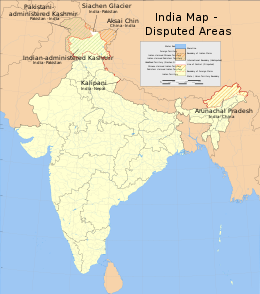
As of 2020, India continues to maintain that the McMahon Line as the legal border, while China has never accepted that border, stating that Tibet was never independent. Around 1962, Chinese troops crossed the McMahon line and attacked Indian border posts in Ladakh, during a one-month war, establishing a "Line of Actual Control". There was a brief border clash in 1967 in the region of Sikkim, in which Indian forces pushed back the Chinese; no further military deaths occurred until 2020. In 1987 and in 2013, potential conflicts over the two differing Lines of Actual Control were successfully de-escalated. A conflict involving a Bhutanese-controlled area on the border between Bhutan and China was successfully de-escalated in 2017 following injuries to both Indian and Chinese troops.[2] Multiple brawls broke out in 2020, escalating to dozens of deaths in June 2020.[3]
The 1962 Sino-Indian War was fought in both of the disputed areas. The agreement to resolve the dispute concluded in 1996 included "confidence-building measures" and the mutually agreed Line of Actual Control. In 2006, the Chinese ambassador to India claimed that all of Arunachal Pradesh is Chinese territory[4] amidst a military buildup.[5] At the time, both countries claimed incursions as much as a kilometre at the northern tip of Sikkim.[6] In 2009, India announced it would deploy additional military forces along the border.[7] In 2014, India proposed China should acknowledge a "One India" policy to resolve the border dispute.[8][9]
Background
Aksai Chin

From the area's lowest point on the Karakash River at about 14,000 feet (4,300 m) to the glaciated peaks up to 22,500 feet (6,900 m) above sea level, Aksai Chin is a desolate, largely uninhabited area. It covers an area of about 37,244 square kilometres (14,380 sq mi). The desolation of this area meant that it had no significant human importance other than ancient trade routes crossing it, providing brief passage during summer for caravans of yaks from Xinjiang and Tibet.[10]
One of the earliest treaties regarding the boundaries in the western sector was issued in 1842. The Sikh Empire of the Punjab region had annexed Ladakh into the state of Jammu in 1834. In 1841, they invaded Tibet with an army. Chinese forces defeated the Sikh army and in turn entered Ladakh and besieged Leh. After being checked by the Sikh forces, the Chinese and the Sikhs signed a treaty in September 1842, which stipulated no transgressions or interference in the other country's frontiers.[11] The British defeat of the Sikhs in 1846 resulted in transfer of sovereignty over Ladakh to the British, and British commissioners attempted to meet with Chinese officials to discuss the border they now shared. However, both sides were sufficiently satisfied that a traditional border was recognised and defined by natural elements, and the border was not demarcated.[11] The boundaries at the two extremities, Pangong Lake and Karakoram Pass, were reasonably well-defined, but the Aksai Chin area in between lay largely undefined.[10][12]
The Johnson Line
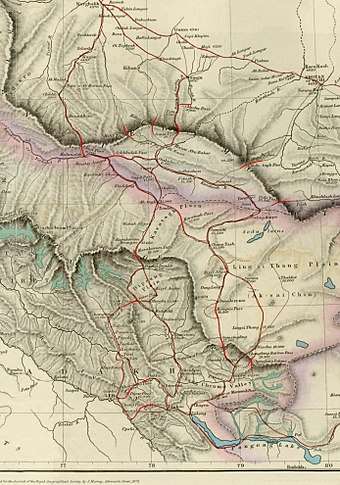
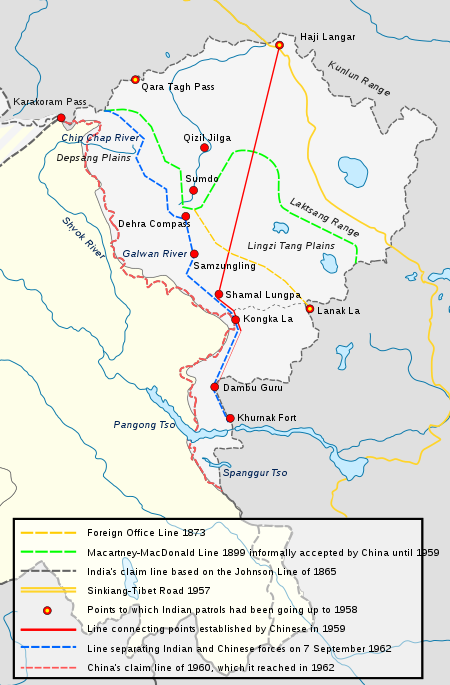
W. H. Johnson, a civil servant with the Survey of India proposed the "Johnson Line" in 1865, which put Aksai Chin in Jammu and Kashmir. This was the time of the Dungan revolt, when China did not control Xinjiang, so this line was never presented to the Chinese. Johnson presented this line to the Maharaja of Jammu and Kashmir, who then claimed the 18,000 square kilometres contained within his territory[13] and by some accounts he claimed territory further north as far as the Sanju Pass in the Kun Lun Mountains. The Maharajah of Jammu and Kashmir constructed a fort at Shahidulla (modern-day Xaidulla), and had troops stationed there for some years to protect caravans.[14] Eventually, most sources placed Shahidulla and the upper Karakash River firmly within the territory of Xinjiang (see accompanying map). According to Francis Younghusband, who explored the region in the late 1880s, there was only an abandoned fort and not one inhabited house at Shahidulla when he was there – it was just a convenient staging post and a convenient headquarters for the nomadic Kirghiz.[15] The abandoned fort had apparently been built a few years earlier by the Dogras.[16] In 1878 the Chinese had reconquered Xinjiang, and by 1890 they already had Shahidulla before the issue was decided.[13] By 1892, China had erected boundary markers at Karakoram Pass.[17]
In 1897 a British military officer, Sir John Ardagh, proposed a boundary line along the crest of the Kun Lun Mountains north of the Yarkand River.[14] At the time Britain was concerned at the danger of Russian expansion as China weakened, and Ardagh argued that his line was more defensible. The Ardagh line was effectively a modification of the Johnson line, and became known as the "Johnson-Ardagh Line".
The Macartney-Macdonald Line

In 1893, Hung Ta-chen, a senior Chinese official at St. Petersburg, gave maps of the region to George Macartney, the British consul general at Kashgar, which coincided in broad details.[18] In 1899, Britain proposed a revised boundary, initially suggested by Macartney and developed by the Governor General of India Lord Elgin. This boundary placed the Lingzi Tang plains, which are south of the Laktsang range, in India, and Aksai Chin proper, which is north of the Laktsang range, in China. This border, along the Karakoram Mountains, was proposed and supported by British officials for a number of reasons. The Karakoram Mountains formed a natural boundary, which would set the British borders up to the Indus River watershed while leaving the Tarim River watershed in Chinese control, and Chinese control of this tract would present a further obstacle to Russian advance in Central Asia.[19] The British presented this line, known as the Macartney-MacDonald Line, to the Chinese in 1899 in a note by Sir Claude MacDonald. The Qing government did not respond to the note.[20] According to some commentators, China believed that this had been the accepted boundary.[21][22]
1899 to 1945
Both the Johnson-Ardagh and the Macartney-MacDonald lines were used on British maps of India.[13] Until at least 1908, the British took the Macdonald line to be the boundary,[23] but in 1911, the Xinhai Revolution resulted in the collapse of central power in China, and by the end of World War I, the British officially used the Johnson Line. However they took no steps to establish outposts or assert actual control on the ground. In 1927, the line was adjusted again as the government of British India abandoned the Johnson line in favour of a line along the Karakoram range further south. However, the maps were not updated and still showed the Johnson Line.[17]

From 1917 to 1933, the "Postal Atlas of China", published by the Government of China in Peking had shown the boundary in Aksai Chin as per the Johnson line, which runs along the Kunlun mountains.[18][22] The "Peking University Atlas", published in 1925, also put the Aksai Chin in India.[24]:101 When British officials learned of Soviet officials surveying the Aksai Chin for Sheng Shicai, warlord of Xinjiang in 1940–1941, they again advocated the Johnson Line.[13] At this point the British had still made no attempts to establish outposts or control over the Aksai Chin, nor was the issue ever discussed with the governments of China or Tibet, and the boundary remained undemarcated at India's independence.[17]
Since 1947
In 1947 at the time of independence, Aksai Chin was part of India. Upon independence in 1947, the government of India fixed its official boundary in the west, which included the Aksai Chin, in a manner that resembled the Ardagh–Johnson Line, but the Chinese government will never admit. India's basis for defining the border was “chiefly by long usage and custom.”[25] Unlike the Johnson line, India did not claim the northern areas near Shahidulla and Khotan. From the Karakoram Pass (which is not under dispute), the Indian claim line extends northeast of the Karakoram Mountains north of the salt flats of the Aksai Chin, to set a boundary at the Kunlun Mountains, and incorporating part of the Karakash River and Yarkand River watersheds. From there, it runs east along the Kunlun Mountains, before turning southwest through the Aksai Chin salt flats, through the Karakoram Mountains, and then to Pangong Lake.[10]
On 1 July 1954 Prime Minister Nehru wrote a memo directing that the maps of India be revised to show definite boundaries on all frontiers. Up to this point, the boundary in the Aksai Chin sector, based on the Johnson Line, had been described as "undemarcated."[19]
Trans Karakoram Tract
The Johnson Line is not used west of the Karakoram Pass, where China adjoins Pakistan-administered Gilgit–Baltistan. On 13 October 1962, China and Pakistan began negotiations over the boundary west of the Karakoram Pass. In 1963, the two countries settled their boundaries largely on the basis of the Macartney-MacDonald Line, which left the Trans Karakoram Tract 5,800 km2 (2,200 sq mi) / 5,180 km2 (2,000 sq mi) in China, although the agreement provided for renegotiation in the event of a settlement of the Kashmir conflict. India does not recognise that Pakistan and China have a common border, and claims the tract as part of the domains of the pre-1947 state of Kashmir and Jammu. However, India's claim line in that area does not extend as far north of the Karakoram Mountains as the Johnson Line. China and India still have disputes on these borders.[10]
The McMahon Line
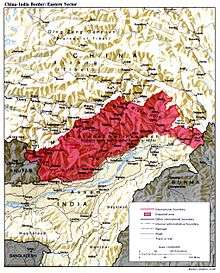
British India annexed Assam in northeastern India in 1826, by Treaty of Yandabo at the conclusion of the First Anglo-Burmese War (1824–1826). After subsequent Anglo-Burmese Wars, the whole of Burma was annexed giving the British a border with China's Yunan province.
In 1913–14, representatives of Britain, China, and Tibet attended a conference in Simla, India and drew up an agreement concerning Tibet's status and borders. The McMahon Line, a proposed boundary between Tibet and India for the eastern sector, was drawn by British negotiator Henry McMahon on a map attached to the agreement. All three representatives initialled the agreement, but Beijing soon objected to the proposed Sino-Tibet boundary and repudiated the agreement, refusing to sign the final, more detailed map. After approving a note which stated that China could not enjoy rights under the agreement unless she ratified it, the British and Tibetan negotiators signed the Simla Convention and more detailed map as a bilateral accord. Neville Maxwell states that McMahon had been instructed not to sign bilaterally with Tibetans if China refused, but he did so without the Chinese representative present and then kept the declaration secret.[10]
V. K. Singh argues that the basis of these boundaries, accepted by British India and Tibet, were that the historical boundaries of India were the Himalayas and the areas south of the Himalayas were traditionally Indian and associated with India. The high watershed of the Himalayas was proposed as the border between India and its northern neighbours. India's government held the view that the Himalayas were the ancient boundaries of the Indian subcontinent and thus should be the modern boundaries of British India and later the Republic of India.[26]
Chinese boundary markers, including one set up by the newly created Chinese Republic, stood near Walong until January 1914, when T. O'Callaghan, an assistant administrator of North East Frontier Agency (NEFA)'s eastern sector, relocated them north to locations closer to the McMahon Line (albeit still South of the Line). He then went to Rima, met with Tibetan officials, and saw no Chinese influence in the area.[17]
By signing the Simla Agreement with Tibet, the British had violated the Anglo-Russian Convention of 1907, in which both parties were not to negotiate with Tibet, "except through the intermediary of the Chinese Government", as well as the Anglo-Chinese Convention of 1906, which bound the British government "not to annex Tibetan territory."[27] Because of doubts concerning the legal status of the accord, the British did not put the McMahon Line on their maps until 1937, nor did they publish the Simla Convention in the treaty record until 1938. Rejecting Tibet's 1913 declaration of independence, China argued that the Simla Convention and McMahon Line were illegal and that Tibetan government was merely a local government without treaty-making powers. In 1947, Tibet requested that India recognise Tibetan authority in the trading town of Tawang, south of the McMahon Line. Tibet did not object to any other portion of the McMahon line. In reply, the Indians asked Tibet to continue the relationship on the basis of the previous British Government.[10]
The British records show that the Tibetan government's acceptance of the new border in 1914 was conditional on China accepting the Simla Convention. Since the British were not able to get an acceptance from China, Tibetans considered the McMahon line invalid.[28] Tibetan officials continued to administer Tawang and refused to concede territory during negotiations in 1938. The governor of Assam asserted that Tawang was "undoubtedly British" but noted that it was "controlled by Tibet, and none of its inhabitants have any idea that they are not Tibetan." During World War II, with India's east threatened by Japanese troops and with the threat of Chinese expansionism, British troops secured Tawang for extra defence.[17]
China's claim on areas south of the McMahon Line, encompassed in the NEFA, were based on the traditional boundaries. India believes that the boundaries China proposed in Ladakh and Arunachal Pradesh have no written basis and no documentation of acceptance by anyone apart from China. Indians argue that China claims the territory on the basis that it was under Chinese imperial control in the past,[26] while Chinese argue that India claims the territory on the basis that it was under British imperial control in the past.[29] The last Qing emperor's 1912 edict of abdication authorised its succeeding republican government to form a union of "five peoples, namely, Manchus, Han Chinese, Mongols, Muslims, and Tibetans together with their territory in its integrity."[30] However, the practice that India does not place a claim to the regions which previously had the presence of the Mauryan Empire and Chola Dynasty, but which were heavily influenced by Indian culture, further complicates the issue.[26]
India's claim line in the eastern sector follows its interpretation of the McMahon Line. The line drawn by McMahon on the detailed 24–25 March 1914 Simla Treaty maps clearly starts at 27°45’40"N, a trijunction between Bhutan, China, and India, and from there, extends eastwards.[10] Most of the fighting in the eastern sector before the start of the war would take place immediately north of this line.[17][31] However, India claimed that the intent of the treaty was to follow the main watershed ridge divide of the Himalayas based on memos from McMahon and the fact that over 90% of the McMahon Line does in fact follow the main watershed ridge divide of the Himalayas. They claimed that territory south of the high ridges here near Bhutan (as elsewhere along most of the McMahon Line) should be Indian territory and north of the high ridges should be Chinese territory. In the Indian claim, the two armies would be separated from each other by the highest mountains in the world.
During and after the 1950s, when India began patrolling this area and mapping in greater detail, they confirmed what the 1914 Simla agreement map depicted: six river crossings that interrupted the main Himalayan watershed ridge. At the westernmost location near Bhutan north of Tawang, they modified their maps to extend their claim line northwards to include features such as Thag La ridge, Longju, and Khinzemane as Indian territory.[10] Thus, the Indian version of the McMahon Line moves the Bhutan-China-India trijunction north to 27°51’30"N from 27°45’40"N.[10] India would claim that the treaty map ran along features such as Thag La ridge, though the actual treaty map itself is topographically vague (as the treaty was not accompanied with demarcation) in places, shows a straight line (not a watershed ridge) near Bhutan and near Thag La, and the treaty includes no verbal description of geographic features nor description of the highest ridges.[10][32]
Sikkim
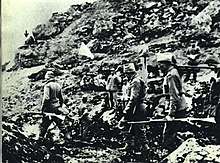
The Nathu La and Cho La clashes were a series of military clashes in 1967 between India and China alongside the border of the Himalayan Kingdom of Sikkim, then an Indian protectorate. The end of the conflicts saw a Chinese military withdrawal from Sikkim.
In 1975, the Sikkimese monarchy held a referendum, in which the Sikkemese voted overwhelmingly in favour of joining India.[33][34] At the time China protested and rejected it as illegal. The Sino-Indian Memorandum of 2003 was hailed as a de facto Chinese acceptance of the annexation.[35] China published a map showing Sikkim as a part of India and the Foreign Ministry deleted it from the list of China's "border countries and regions".[35] However, the Sikkim-China border's northernmost point, "The Finger", continues to be the subject of dispute and military activity.[6]
Chinese Prime Minister Wen Jiabao said in 2005 that "Sikkim is no longer the problem between China and India."[36]
Boundary discussions and disputes
1947–1962
During the 1950s, the People's Republic of China built a 1,200 kilometres (750 mi) road connecting Xinjiang and western Tibet, of which 179 kilometres (111 mi) ran south of the Johnson Line through the Aksai Chin region claimed by India.[17][10] Aksai Chin was easily accessible from China, but for the Indians on the south side of the Karakoram, the mountain range proved to be a complication in their access to Aksai Chin.[10] The Indians did not learn of the existence of the road until 1957, which was confirmed when the road was shown in Chinese maps published in 1958.[37]
The Indian position, as stated by prime minister Jawaharlal Nehru, was that the Aksai Chin was "part of the Ladakh region of India for centuries" and that this northern border was a "firm and definite one which was not open to discussion with anybody".[10]
The Chinese minister, Zhou Enlai argued that the western border had never been delimited, that the Macartney-MacDonald Line, which left the Aksai Chin within Chinese borders was the only line ever proposed to a Chinese government, and that the Aksai Chin was already under Chinese jurisdiction, and that negotiations should take into account the status quo.[10]
In 1960, based on an agreement between Nehru and Zhou Enlai, officials from India and China held discussions in order to settle the boundary dispute.[24] China and India disagreed on the major watershed that defined the boundary in the western sector.[24]:96 The Chinese statements with respect to their border claims often misrepresented the cited sources.[38]
1967 Nathu La and Cho La clashes
The Nathu La and Cho La clashes were a series of military clashes in 1967, between India and China alongside the border of the Himalayan Kingdom of Sikkim, then an Indian protectorate.[39][40]
The Nathu La clashes started on 11 September 1967, when the People's Liberation Army (PLA) launched an attack on Indian posts at Nathu La, and lasted till 15 September 1967. In October 1967, another military duel took place at Cho La and ended on the same day.[41]
According to independent sources, the Indian forces achieved "decisive tactical advantage" and defeated the Chinese forces in these clashes. Many PLA fortifications at Nathu La were said to be destroyed, where the Indian troops drove back the attacking Chinese forces.[42]
1968–2017
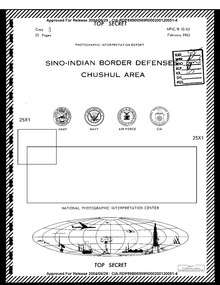
On 20 October 1975, 4 Indian soldiers were killed at Tulung La in Arunachal Pradesh.[43][44] According to the official statement by the Indian government, a patrol of the Assam Rifles comprising a non-commissioned officer (NCO) and four other soldiers was ambushed by about 40 Chinese soldiers while in an area well within Indian territory, and which had been regularly patrolled for years without incident. Four members of the patrol unit were initially listed as missing before confirmation via diplomatic channels they had been killed by the Chinese troops; their bodies were later returned. The Indian government registered a strong protest with the Chinese.[45] In April 2013 India claimed, referencing their own perception[46] of the Line of Actual Control (LAC) location, that Chinese troops had established a camp in the Daulat Beg Oldi sector, 10 km (6.2 mi) on their side of the Line of Actual Control. This figure was later revised to a 19 km (12 mi) claim. According to Indian media, the incursion included Chinese military helicopters entering Indian airspace to drop supplies to the troops. However, Chinese officials denied any trespassing having taken place.[47][48] Soldiers from both countries briefly set up camps on the ill-defined frontier facing each other, but the tension was defused when both sides pulled back soldiers in early May.[49] In September 2014, India and China had a standoff at the LAC, when Indian workers began constructing a canal in the border village of Demchok, Ladakh, and Chinese civilians protested with the army's support. It ended after about three weeks, when both sides agreed to withdraw troops.[50] The Indian army claimed that the Chinese military had set up a camp 3 km (1.9 mi) inside territory claimed by India.[51] An article on the BBC website states that China gains territory with every incursion.[52]
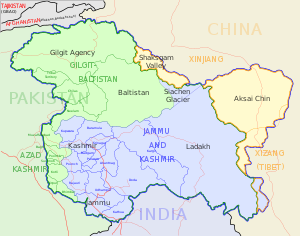
In September 2015, Chinese and Indian troops faced-off in the Burtse region of northern Ladakh after Indian troops dismantled a disputed watchtower the Chinese were building close to the mutually-agreed patrolling line.[53]
2017 Doklam Military Standoff
In June, a military standoff occurred between India and China in the disputed territory of Doklam, near the Doka La pass. On June 16, 2017, the Chinese brought heavy road building equipment to the Doklam region and began constructing a road in the disputed area.[54] Previously, China had built a dirt road terminating at Doka La where Indian troops were stationed.[54] They would conduct foot patrol from this point up till the Royal Bhutanese Army (RBA) post at Jampheri Ridge.[54] The dispute that ensued post June 16 stemmed from the fact that the Chinese had begun building a road below Doka La, in what India and Bhutan claim to be disputed territory.[54] This resulted in Indian intervention of China's road construction on June 18, two days after construction began. Bhutan claims that the Chinese have violated the written agreements between the two countries that were drawn up in 1988 and 1998 after extensive rounds of talks.[55] The agreements drawn state that status quo must be maintained in the Doklam area as of before March 1959.[55] It is these agreements that China has violated by constructing a road below Doka La. A series of statements from each countries' respective External Affairs ministries were issued defending each countries' actions. Due to the ambiguity of earlier rounds of border talks beginning from the 1890 Anglo-Chinese Convention that was signed in Kolkata on March 17, 1890, each country refers to different agreements drawn when trying to defend its position on the border dispute.[54][55] Following the incursion, on June 28, the Chinese military claimed that India had halted construction of a road that was taking place in Chinese sovereign territory.[56] On June 30, India's Foreign Ministry claimed that China's road construction in violation of the status quo had security implications for India.[57] Following this, on July 5, Bhutan issued a demarche asking China to restore the status quo as of before June 16.[58] Throughout July and August, the Doklam issue remained unresolved. On August 28, India issued a statement saying that both countries have agreed to "expeditious disengagement" in the Doklam region.[56]
2020 skirmishes
In June 2020, Indian and Chinese troops engaged in a brawl in the Galwan River valley which reportedly led to the death of 20 Indian Soldiers. Claims have been made of death of 40+ Chinese Soldiers but such claims have been denied by Chinese authorities.[59][60]
Dispute resolution mechanism
Bilateral treaties
Indian spokesperson for the Ministry of External Affairs, Anurag Srivastava, stated that there were enough bilateral mechanisms to solve border disputes diplomatically.[61][62] These agreements encompass:[61]
Five bilateral treaties between India and China to address border disputes
- 1993: Agreement on the maintenance of peace and tranquility along the Line of Actual Control in the Sino-Indian Border
- 1996: Agreement between the Government of the Republic of India and the Government of the People's Republic of China on confidence-building Measures in the military field along the Line of Actual Control in the Sino-Indian Border
- 2005: Protocol on the modalities for the implementation of confidence-building measures in the military field along the Line of Actual Control in the Sino-Indian Border
- 2012: Establishment of a working mechanism for consultation and coordination on Sino-Indian border affairs
- 2013: Border defense cooperation agreement between India and China
Additionally there are other agreements related to the border question such as the 2005 "Agreement on the Political Parameters and Guiding Principles for the Settlement of the India-China Boundary Question".[63][64] However, some critics say that these agreements are "deeply flawed".[65]
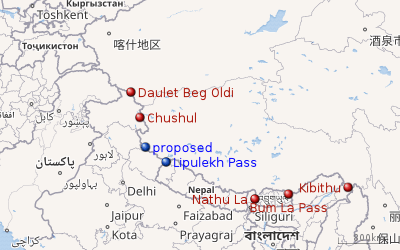 |
| Border Personnel Meeting points (existing in red, proposed/discussed in blue) |
Border meeting points
There are five Border Personnel Meeting points (BPM) for holding rounds of dispute resolution talks among the military personnel with a defined escalation path, such as first between colonels, then between brigadiers, and finally between major generals.[66][67] Of these five BPM, two are in the Indian Union Territory of Ladakh or India's western (northern) sector corresponding to China's Southern Xinxiang Military District, one in Sikkim and two in Arunachal Pradesh in India's central and eastern sectors corresponding to China's Tibet Military District.
Geostrategic military aspects
Commands and troops deployment


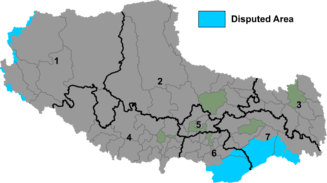
Chinese Military has an integrated Western Theater Command (WTC) across the whole LAC with India. Western Theater Command also covers provinces of Sichuan, Gansu, Ningxia, Qinghai and Chongqing. China has 5 integrated theater commands.[68]
Indian Military has divided the LAC into 3 sectors - the northern sector (some times lso called western sector) across Ladakh and the Chinese-held Aksai Chin, the central sector across Himachal Pradesh and Uttrakhand states, and the eastern sector across Sikkim and Arunachal Pradesh states.[69][70] Similarly, Indian Airforce has Prayagraj-based Western Air Command, Delhi-based Central Air Command, and Shillong-based Eastern Air Command to cover the LAC.[69] India, whose sole integrated command is Andaman and Nicobar Command, is still going through integration of its various geography and services based commands as of 2020.[71][72]
Belfer Center for Science and International Affairs (BCSIA) carried out an independent analysis of troops deployment in 2020. Indian Army strike forces has 225,000 soldiers near China border all of whom are focused on China, 34,000 in the Northern Command, 15,500 in the Central Command, and 175,500 troops in the Eastern Command, including 3,000 soldiers of T-72 tank brigade in Ladakh and 1,000 soldiers of BrahMos cruise missile regiment in Arunachal Pradesh. Of the 200,00 to 230,000 ground forces under the China's Western Theater Command, only 110,000 are available for focusing on the Indian border, rest are deployed on protecting China's border with Russian in north, and for suppression of internal rebellion in restive Tibet and Xinjinag, or deployed elsewhere deep inside Chinese provinces. Chinese troops aimed at India border, who belong mainly to 76th Group Army and 77th Group Army, 70,000 are deployed in Southern Xinjiang Military District (corresponding to India's northern or western sector in Ladakh) and 40,000 are deployed in Tibet Military District (corresponding to India's central and eastern sector along rest of the LAC from Himachal Pradesh to Arunachal Pradesh), rest will be not be available for deployment on India border in the case of war. This creates a disparity in terms of India's larger number of conventional troops (225,000) focused on China border compared to the smallernumber of Chinese troops (90,000-120,000) focused on the Indian border majority of whom are deployed far from the Indian border while Indian troops are deployed with single mission of defence against china. In case of stand offs, while Indian troops are already in position on or near border, China will have to mobalise troops mainly from Xinjiang and secondarily from other troops of Western Theater Command in deep iinteriors of China.[69]
Command deployment is as follows:[70]
| India | China | |
|---|---|---|
| Indian Army Sector / Commands | Indian Airforce | |
| Northern (also called "Western")[69] (Ladakh) |
Western Air Command (Delhi) |
Western Theater Command (Xinjiang and Tibet) |
| Central (Himachal Pradesh and Uttrakhand) |
Central Air Command (Prayagraj) | |
| Eastern (Sikkim and Arunachal Pradesh) |
Eastern Air Command (Shillong) | |
Noncontiguous disputed areas
List of noncontiguous disputed areas,[70] each with several hundred to several thousand sqkm area, is as follows:
| SN | Disputed area / sector (alternate names) |
Chinese Province | Indian State/UT | Size in sqkm | Operational control | Incidences / comment |
|---|---|---|---|---|---|---|
| 1 | Trans-Karakoram Tract (Shaksgam) | Xinjiang | Ladakh | China | Conditionally ceded by Pakistan to China subject to resolution with India. India-controlled Indira Col West lies on its southern border at India-Pakistan-China westernmost "operational" trijunction. | |
| 2 | Aksai Chin | Xinjiang and Tibet | Ladakh | China | Served by Daulat Beg Oldi AGL,[73] and Darbuk–Shyok–DBO Road. Padum AGL[73] and Leh Airport are 2nd line of defence. China-controlled Shaksgam and Aksai Chin border the India-controlled Siachen area disputed by Pakistan. See also 2013 Daulat Beg Oldi Incident, 2020 China–India skirmishes, Depsang Plains, Galwan, Pangong Tso, Hot Springs, Kongka Pass. Shyok as hot spots in this sector. | |
| 3 | Demchok | Tibet | Ladakh | India | Served by Fukche AGL.[73] Padum AGL[73] and Leh Airport are 2nd line of defence. | |
| 4 | Chumar North | Tibet | Ladakh | India | Served by Nyoma AGL.[73] Chumar sector has 2 noncontiguous areas, north and south. India has road up to the claimed border. China does not have a road up to border. Both India and China are also served by helipads. | |
| 5 | Chumar South | Tibet | Ladakh | India | ||
| 6 | Kaurik (Sumdo) |
Tibet | Himachal Pradesh | India | Served by dual use Shimla Airport and Kullu-Manali Airport.[74] Kibber-Rangrik AGL has been surveyed,[74] which Will be closest AGL to Chumar, Kaurik, and Tashigang-Shipki La disputed area, but as of July 2020 no progress has been made. Himachal Pradesh has a 250 km (160 mi) border with China.[74] India has road up to the claimed border at Bakiala. | |
| 7 | Tashigang-Shipki La (Khab and Namgia) |
Tibet | Himachal Pradesh | India | ||
| 8 | Pulam Sumda (also Mana Pass,[75] Nelang, Sang Jadhang, and Tirpani) |
Tibet | Himachal Pradesh | India | ||
| 9 | Bara Hoti | Tibet | Uttrakhand[75] | India | Chinyalisaur Airport primarily and Pithoragarh Airport secondarily serve Bara Hoti and Nelang-Pulam Sumda sectors as AGLs. ITBP has 42 BoPs (border outposts) in Bara Hoti sector and Mana Pass area (Pulam Sumda sector).[75] Uttrakhand has a 350 km (220 mi) border with China.[75] India is building roads in this sector,[76][77] which will be completed by December 2020.[78][79] | |
| 10 | Arunachal Pradesh (especially Tawang) | Tibet | India | Tawang Air Force Station and AGLs at Aalo, Mechuka, Pasighat, Tuting, Vijoynagar, Walong and Ziro serve this sector.[80] Most of India-controlled Arunachal Pradesh is also claimed by China, especially Tawang. See also 1987 Sino-Indian skirmish at Tawang. | ||
Bhutan's Doklam area on Sikkim-China-Bhutan tri-junction, disputed by China in which Bhutan is assisted by India, has been kept out of this list, see also 2017 China–India border standoff at Doklam and Nathu La and Cho La clashes in Sikkim.
See also
- Annexation of Tibet by the People's Republic of China
- China containment policy
- India-China Border Roads
- List of disputed territories of China
- List of disputed territories of India
- List of territorial disputes
- McMahon Line
- Sino-Indian relations
- Sino-Indian War
References
- Hoffmann, India and the China Crisis (1990), p. 19.
- Ramachandran, Sudha (15 July 2020). "Beijing Asserts a More Aggressive Posture in Its Border Dispute with India". Jamestown Foundation. Retrieved 17 July 2020.
- Goldman, Russell (17 June 2020). "India-China Border Dispute: A Conflict Explained". The New York Times. Retrieved 27 June 2020.
- "Arunachal Pradesh is our territory": Chinese envoy Rediff India Abroad, 14 November 2006. Archived 8 November 2011 at the Wayback Machine
- Subir Bhaumik, "India to deploy 36,000 extra troops on Chinese border", BBC, 23 November 2010. Archived 2 January 2012 at the Wayback Machine
- Sudha Ramachandran, "China toys with India's border", Asia Times Online, 27 June 2008. Archived 22 November 2009 at the Stanford Web Archive
- "The China-India Border Brawl", Wall Street Journal, 24 June 2009, archived from the original on 23 September 2011
- 何, 宏儒 (12 June 2014). "外長會 印向陸提一個印度政策". 中央通訊社. 新德里. Archived from the original on 27 February 2017. Retrieved 27 February 2017.
- "印度外長敦促中國重申「一個印度」政策". BBC 中文网. Archived from the original on 27 February 2017. Retrieved 27 February 2017.
- Maxwell, India's China War (1970)
- The Sino-Indian Border Disputes, by Alfred P. Rubin, The International and Comparative Law Quarterly, Vol. 9, No. 1. (Jan. 1960), pp. 96–125. JSTOR 756256.
- Guruswamy, Mohan (2006). Emerging Trends in India-China Relations. India: Hope India Publications. p. 222. ISBN 978-81-7871-101-0. Archived from the original on 25 June 2016. Retrieved 27 October 2015.
- Mohan Guruswamy, Mohan, "The Great India-China Game", Rediff, 23 June 2003. Archived 30 September 2016 at the Wayback Machine.
- Woodman, Himalayan Frontiers (1970), pp. 101, 360–
- Younghusband, Francis E. (1896). The Heart of a Continent. John Murray, London. Facsimile reprint: (2005) Elbiron Classics, pp. 223–224.
- Grenard, Fernand (1904). Tibet: The Country and its Inhabitants. Fernand Grenard. Translated by A. Teixeira de Mattos. Originally published by Hutchison and Co., London. 1904. Reprint: Cosmo Publications. Delhi. 1974, pp. 28–30.
- Calvin, James Barnard (April 1984). "The China-India Border War". Marine Corps Command and Staff College. Archived from the original on 11 November 2011.
- Woodman, Himalayan Frontiers (1970), pp. 73, 78
- Noorani, A.G. (30 August 2003), "Fact of History", Frontline, vol. 26 no. 18, archived from the original on 2 October 2011
- Woodman, Himalayan Frontiers (1970), pp. 102: "The proposed boundary seems never to have been considered in the same form again until Alastair Lamb revived it in 1964".
- "India-China Border Dispute". GlobalSecurity.org. Archived from the original on 15 February 2015.
- Verma, Virendra Sahai (2006). "Sino-Indian Border Dispute At Aksai Chin - A Middle Path For Resolution" (PDF). Journal of Development Alternatives and Area Studies. 25 (3): 6–8. ISSN 1651-9728. Archived (PDF) from the original on 19 October 2013.
- Woodman, Himalayan Frontiers (1970), pp. 79
- Fisher, Rose & Huttenback, Himalayan Battleground (1963), p. 91
- Raghavan, War and Peace in Modern India 2010, p. 235
- V. K. Singh, Resolving the boundary dispute, india-seminar.com. Archived 18 October 2006 at the Wayback Machine
- Karunakar Gupta. The McMahon Line 1911–45: The British Legacy, The China Quarterly, No. 47. (Jul. – Sep. 1971), pp. 521–545. JSTOR 652324
- Tsering Shakya (1999). The Dragon in the Land of Snows: A History of Modern Tibet Since 1947. Columbia University Press. pp. 279–. ISBN 978-0-231-11814-9. Archived from the original on 30 March 2017. Retrieved 31 March 2017.
- Arthur A. Stahnke. "The Place of International Law in Chinese Strategy and Tactics: The Case of the Sino-Indian Boundary Dispute", The Journal of Asian Studies. Vol. 30, No. 1, Nov 1970. pg. 95–119
- Qing Dynasty Edict of Abdication, translated by Bertram Lenox Putnam Weale, The Fight for the Republic in China, London: Hurst & Blackett, Ltd. Paternoster House, E.C. 1918. – Emphasis added, "Muslims" rendered as "Mohammedans" in original translation
- A.G. Noorani, "Perseverance in peace process". Frontline, 29 August 2003. Archived 26 March 2005 at the Wayback Machine
- T. S. Murty & Neville Maxwell, Tawang and "The Un-Negotiated Dispute" The China Quarterly, No. 46. (Apr. – Jun. 1971), pp. 357–362. Archived 8 February 2017 at the Wayback Machine.
- "Sikkim (Indien), 14. April 1975 : Abschaffung der Monarchie -- [in German]". www.sudd.ch. Archived from the original on 18 August 2017.
- "Sikkim Votes to End Monarchy, Merge With India". The New York Times. 16 April 1975. Archived from the original on 19 August 2017.
- D. S. Rajan, "China: An internal Account of Startling Inside Story of Sino-Indian Border Talks", South Asia Analysis Group, 10-June-2008. Archived 13 June 2010 at the Wayback Machine
- Scott, David (2011). Handbook of India's International Relations. Routledge. p. 80. ISBN 9781136811319.
-
- Garver, John W. (2006), "China's Decision for War with India in 1962" (PDF), in Robert S. Ross (ed.), New Directions in the Study of China's Foreign Policy, Stanford University Press, ISBN 978-0-8047-5363-0, archived from the original on 28 August 2017
- Fisher, Rose & Huttenback, Himalayan Battleground (1963), p. 99.
- Krishnan, Ananth (30 July 2017). "The last Sikkim stand-off: When India gave China a bloody nose in 1967". India Today. Archived from the original on 25 December 2018. Retrieved 27 May 2020.
- Rana, Sonal (7 September 2018). "Know about the Nathu La and Cho La clashes of 1967 that inspired Paltan". The Statesman.
- M.L.Sali (1998). India-China Border Dispute: A Case Study of the Eastern Sector. 236: APH Publishing. p. 313. ISBN 9788170249641.CS1 maint: location (link)
- Patranobis, Sutirtho (1 July 2017). "Lessons for India and China from 1967 Nathu La clash". Hindustan Times. Archived from the original on 6 November 2018. Retrieved 27 May 2020.
- https://www.thehindu.com/news/national/forgotten-in-fog-of-war-the-last-firing-on-the-india-china-border/article31827344.ece
- https://theprint.in/india/1975-arunachal-ambush-the-last-time-indian-soldiers-died-in-clash-with-china-at-lac/442674/
- "Spokesman's Statement" (PDF). Press Information Bureau of India - Archive. 1 November 1975. Retrieved 23 June 2020.
- "China's Ladakh Incursion Well-planned". Archived from the original on 19 August 2017.
- "India sends out doves, China sends in chopper", Hindustan Times, archived from the original on 27 May 2013
- "India, China caught in a bitter face-off", Hindustan Times, archived from the original on 26 May 2013
- "India and China 'pull back troops' in disputed border area". BBC News. 6 May 2013. Archived from the original on 13 May 2015. Retrieved 14 September 2015.
- Hari Kumar (26 September 2014). "India and China Step Back From Standoff in Kashmir". New York Times. Archived from the original on 20 July 2016.
- "Chinese and Indian troops in Himalayan standoff", Reuters, 23 September 2014, archived from the original on 11 September 2016
- "Why border stand-offs between India and China are increasing", BBC News, 26 September 2014, archived from the original on 12 September 2016
- "India-China troops face-off near Line of Actual Control in Ladakh", The Economic Times, 13 July 2018, archived from the original on 15 September 2015
- Manoj Joshi, Doklam: To Start at the Very Beginning Archived 30 October 2017 at the Wayback Machine
- Manoj Joshi, Doklam, Gipmochi, Gyemochen: It’s Hard Making Cartographic Sense of a Geopolitical Quagmire Archived 4 August 2017 at the Wayback Machine
- HT Correspondent Blow by blow: A timeline of India, China face-off over Doklam Archived 7 November 2017 at the Wayback Machine
- A Staff Writer Doklam standoff ends: A timeline of events over the past 2 months Archived 2 November 2017 at the Wayback Machine
- Shishir Gupta, Bhutan issues demarche to Beijing, protests over India-China border row Archived 2 November 2017 at the Wayback Machine
- Gettleman, Jeffrey; Kumar, Hari; Yasir, Sameer (16 June 2020). "3 Indian Soldiers Killed in First Deadly Clash on Chinese Border in Decades". The New York Times. ISSN 0362-4331. Retrieved 16 June 2020.
- https://zeenews.india.com/india/over-40-chinese-troops-killed-in-galwan-valley-violent-clash-sources-2291138.html
- Gill, Prabhjote (29 May 2020). "India says there are five treaties to push the Chinese army behind the Line of Actual Control – while experts tell Modi to remain cautious". Business Insider. Retrieved 3 June 2020.
- Chaudhury, Dipanjan Roy (29 May 2020). "India-China activate 5 pacts to defuse LAC tensions". The Economic Times. Retrieved 3 June 2020.
- "Agreement between the Government of the Republic of India and the Government of the People's Republic of China on the Political Parameters and Guiding Principles for the Settlement of the India-China Boundary Question". Ministry of External Affairs, Government of India. 11 April 2005. Retrieved 20 June 2020.
- Sino-India relations including Doklam, Situation and Cooperation in International Organizations (2017-18) (PDF) (Report). Ministry of External Affairs, Government of India.
- Sudarshan, V. (1 June 2020). "A phantom called the Line of Actual Control". The Hindu. ISSN 0971-751X. Retrieved 3 June 2020.
- Gupta, Shishir (5 June 2020). "Ahead of today's meet over Ladakh standoff, India signals a realistic approach". Hindustan Times. Retrieved 6 June 2020.
- "Eye on India, China raises Tibet military command rank | Central Tibetan Administration". tibet.net. Retrieved 1 October 2016.
- India-China War: US Study Explains Why Indian Air Force Could Outgun China In A Border Conflict, Eurasian Times, July 24, 2020.
- "Twisting India's Chicken's Neck". lowyinstitute.org. Retrieved 18 July 2020.
- Indian Army’s new Integrated Battle Groups to be introduced in early 2020, The Print, 26 November 2019.
- news-analysis/theatre-command-in-india Theatre Command in India, The Print, 04 May 2019.
- India plans AGL strips, Deccan Herald, 2014.
- Himachal Pradesh: Demand for airstrip in Spiti area, TImes of India, 17 July 2020.
- Eyeing national security, Uttarakhand, ITBP to improve border infrastructure, Hindustan Times, 18 July 2020.
- "Joshimath-Malari highway inaugurated". www.projectstoday.com. 26 December 2019. Retrieved 19 June 2020.
- "BRO officials asked to speed up pending road projects". Hindustan Times. 20 February 2018. Retrieved 19 June 2020.
- Singh, Vijaita (3 March 2018). "Govt. puts delayed road projects on Indo-China border on track". The Hindu. ISSN 0971-751X. Retrieved 18 June 2020.
- Singh, Jitendra Bahadur (17 June 2020). "India to accelerate construction of roads along Chinese border: Sources". India Today. Retrieved 18 June 2020.
- IAF to have seven AGL in Arunachal Pradesh, Economic Times, 2018.
Bibliography
- Fisher, Margaret W.; Rose, Leo E.; Huttenback, Robert A. (1963), Himalayan Battleground: Sino-Indian Rivalry in Ladakh, Praeger – via archive.org
- Hoffmann, Steven A. (1990), India and the China Crisis, University of California Press, ISBN 978-0-520-06537-6
- Hoffmann, Steven A. (2018) [first published 1990], India and the China Crisis, University of California Press, ISBN 978-0-520-06537-6
- Raghavan, Srinath (2010), War and Peace in Modern India, Palgrave Macmillan, ISBN 978-1-137-00737-7
- Woodman, Dorothy (1969), Himalayan Frontiers: A Political Review of British, Chinese, Indian, and Russian Rivalries, Praeger – via archive.org
Further reading
| Library resources about Sino-Indian border dispute |
| Wikimedia Commons has media related to Maps of Sino-Indian border dispute. |
- The McMahon Line – A Century of Discord written by General J. J. Singh, provides a detailed description of the border dispute between India and China.
- Johny, Stanly (20 July 2019). "'The McMahon Line – A Century of Discord' review: The disputed frontier". The Hindu. Archived from the original on 18 October 2019. Retrieved 18 October 2019.
- Maxwell, Neville (1970), India's China War, Pantheon Books, ISBN 978-0-394-47051-1. Also available on scribd.